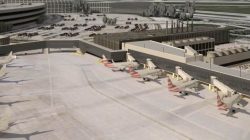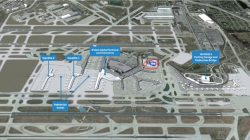Chicago’s Mayor, Rahm Emanuel, and various airline carriers serving O’Hare international airport are in the final stages of negotiating an $8.5 billion deal to expand the airport from its current size. The plans will include increasing the number of gates from its current 189 to 220 and growing the airport from 4.3 million to 7.4 million square feet.
If approved, the deal will be the largest and most expensive terminal redesign project in O’Hare’s history, and there are huge implications for travelers and all current and future airline tenants who pass through Chicago each year.

Chicago O’Hare Today
Chicago O’Hare has four terminal facilities in use: Terminal 1 houses all of United Airlines’ mainline flights, along with a few United Express regional flights, and it also serves as the departures location for United’s Star Alliance partners Lufthansa and All Nippon Airways, which fly from Chicago to Frankfurt, Munich, Tokyo Narita, and Tokyo Haneda. All of United’s international and long-haul flights also depart from Terminal 1. There are two concourses at Terminal 1: Concourse B, which is connected to the check-in, non-sterile passenger drop-off/pick-up areas, and Concourse C, which is a mid-field concourse that is connected via underground walkways.
Terminal 2 at O’Hare is where Delta, Delta Connection, Air Canada, its regional partners Air Canada Express/Sky Regional, and some United Express flights operate from. There are two concourses here: E and F.
Terminal 3 is home to American Airlines and American Eagle. It is also the home to JetBlue, Alaska, Spirit, Frontier, and Air Choice One. All of American’s international and long-haul flights depart from Terminal 3, and its joint venture partners Iberia and Japan Airlines also depart from Terminal 3 to Madrid and Tokyo Narita, respectively.
Finally, Terminal 5 is where all international flights are handled, with the exception of departures on United and American, as well as the four aforementioned airlines (Lufthansa, Iberia, Japan Airlines, and All Nippon Airways) which operated out of T1 or T3. All international arrivals into Chicago O’Hare arrive into Terminal 5 irrespective of which airline is operating them, with the exception of a few which come from countries with U.S. Pre-border Clearance (such as Canada, Aruba, some Ireland, the Bahamas, etc).
In total, the 189 gates are spread out as follows:
Terminal 1: 50 gates (United, United Express, Lufthansa, All Nippon Airways)
- Concourse B – 22 gates
- Concourse C – 28 gates
Terminal 2: 43 gates (Air Canada, Delta, Delta Connection, and United Express)
- Concourse E – 17 gates
- Concourse F – 26 gates
Terminal 3: 75 gates, +5 near completion (American, American Eagle, Iberia, JAL, Alaska, Frontier, Spirit, JetBlue, Air Choice One)
- Concourse G – 25 gates
- Concourse H – 17 gates
- Concourse K – 16 gates
- Concourse L – 17 gates, +5 new “stinger” gates coming this year
Terminal 5: 21 gates +9 in the pipeline to be added (all other airlines)
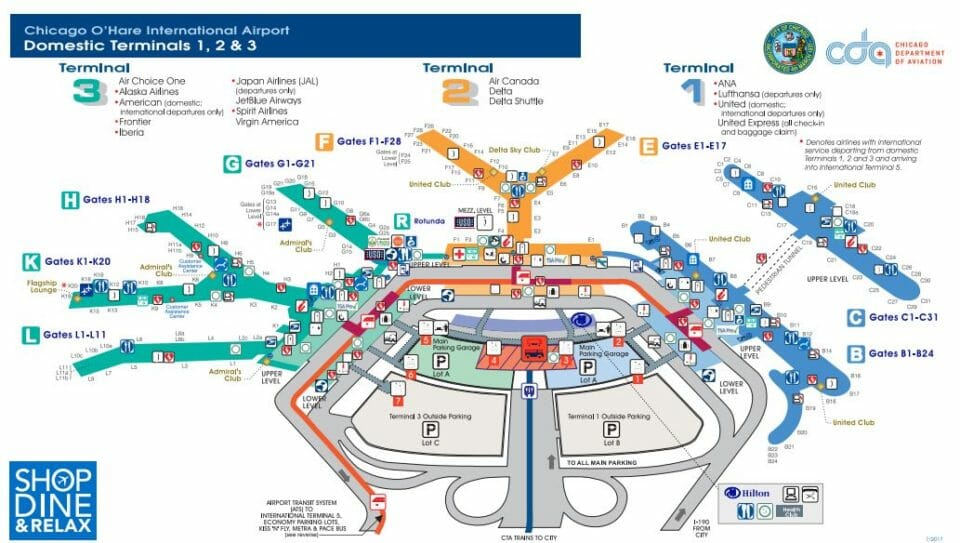
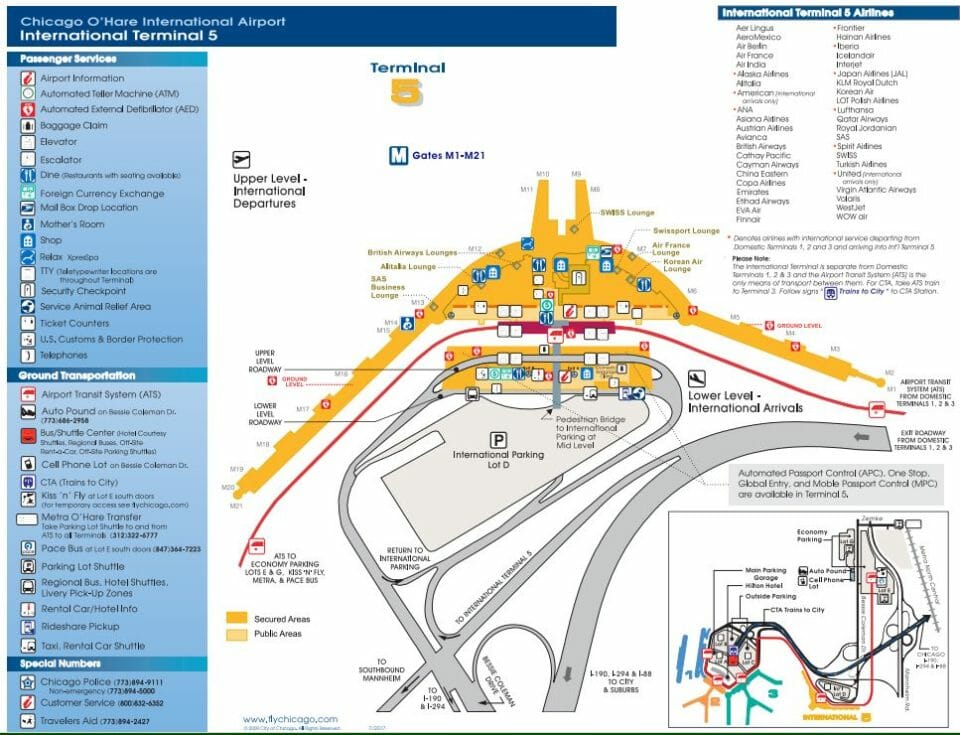
What Are the Challenges O’Hare Faces Today?
Chicago O’Hare can be a polarizing airport: on one hand, it is truly a pleasure to inhabit given how well the airport facilities reflect the richness of the City of Chicago in just about every way, from its food and beverage selections to its retail to artwork, music, architecture, connectivity to public transit, and so forth. It’s also a great spotting haven.
On the other hand, it can be frustrating: weather delays (though not specific to O’Hare, but a variable nevertheless) add levels of uncertainty and anxiety to the travel experience to ORD, along with the terminal layouts for connecting passengers. Getting from one side of the airport to another, particularly with any transfers that involve a connection to Terminal 5, can be a hassle. Thankfully, there have been efforts made to mitigate this level of stress thanks to the new terminal shuttle bus, which came out in 2017.
Aside from nasty weather and an outdated airport layout, O’Hare really suffers from two issues: 1) having outdated terminal facilities and 2) an insufficient number of gates to accommodate current, much less allow for additional, growth.
An article in the Chicago Tribune claims that despite O’Hare’s already massive size, in terms of passengers carried, its number of daily departures and the overall roster of international airlines and destinations is disproportionate to the economic and political power of the City of Chicago.
There has also been a 12 billion expenditure to realign ORD’s runways from its former layout, where 6 of them intersected haphazardly, to six parallel ones with 2 intersecting diagonally. The runway construction was funded thanks to federal grants from the Obama administration. While this is great in terms of easing the congestion issues at O’Hare, its full potential is not being realized with the current terminal layout.
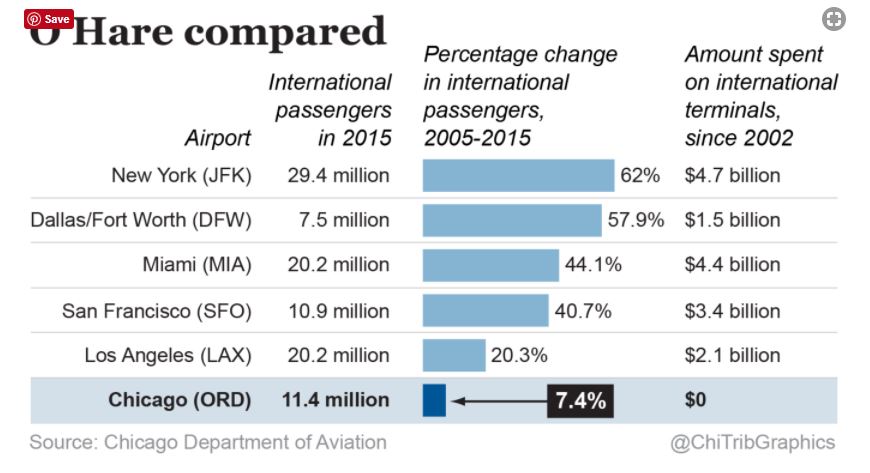
And while all of ORD’s tenants would ideally like more gates and upgraded facilities, the reality is that much of the progress and development that could have taken place in the past has been stymied by opposition from its largest hub carriers, American Airlines and United Airlines. There have been talks since 2002 to add additional gate facilities and new terminal buildings, but those discussions have amounted to nothing more than that: just talks. Former Mayor Richard Daley had proposed the O’Hare Modernization Program, which was approved in 2005, to build a western terminal at ORD, but this received opposition from American and United Airlines. Both carriers operate hubs at O’Hare and felt that they would ultimately be the stakeholders who would have to front the majority of the construction costs for facilities that likely would be used by smaller carriers. So, the plan was shelved.
In American and United’s defense, the post-9/11 era was a turbulent period for both carriers and they had other pressing matters to tend to in order to stay alive. Now, flush with cash, they have a bit more financial wherewithal to soften their stances on the matter. After all, there is an incentive for them as well to upgrade facilities and claim more gates in order to grow their hubs at the airport.
But why now? The airlines 30-year lease period with the city ends in May 2018, and therefore opens up the door to renegotiations in terms of landing fees, rent, and other matters. Unlike the runway construction efforts, Mayor Emanuel has stated that any approved terminal renovation at O’Hare will not come from the federal government. Instead, the city will borrow against future increased fees and charges that airlines will pay as part of the new lease agreements and Passenger Facilities Charges (PFC’s).
The Case for Increased Landing Fees
American and United stand much to gain from this transaction. Both carriers have underscored the importance of Chicago O’Hare to their global route networks given its primary location in the geographic center of the United States, and Chicago’s global importance as an economic powerhouse. On an international front, while American and United have added some international flights from O’Hare to various corners of the world in recent years, much of the overall international growth at ORD has come via foreign carriers and alliance partners rather than on their own metal.
Some of that has to do with demand, but gate space is another huge concern. American has been able to alleviate some of its issues by adding five new gates in the L-Terminal, known as the “stinger” gates. Due to space issues, these will only be able to service regional flights from the facilities once they are fully constructed in a few months. These gates, moreover, have been a sticking point in the current negotiations as to whether they should be considered, “existing” gates that American can count towards its current total before the pie is divided up, or “new” gates that will come out of American’s piece of the pie once its carved out. American obviously wants the former, while United wants the latter.
Collectively, however, both carriers have some apprehensions about customer pushback when it comes to increased landing fees and PFCs, which are naturally passed on to the passenger through ticket sales. According to the Tribune, O’Hare’s average passenger cost per enplanement was less than $15 in 2015 but will rise to $20 this year and is projected to hit $25 in 2025.
Ultimately, even though passenger enplanement costs are such a hang-up, the City of Chicago has a, “if we build it, they will come” mentality. My takeaway is that they feel Chicago shouldn’t be concerned about how far ahead it pulls in terms of enplanement costs compared to markets like Dallas, Atlanta, Charlotte, or Denver, which are much lower than Chicago’s. Rather, Chicago should be baselining itself against “top dog,” major international airports like New York JFK, Los Angeles, San Francisco, and Miami, which I agree with.
The Proposal
If the negotiations are successful, then the $8.5 billion plan would take 8 years to complete – by 2026. The key component of this plan? Replacing Terminal 2 with a new “Global Terminal” that has wider concourses and gates to accommodate larger aircraft (such as more Airbus A380s) and co-locate such flights closer to United and American in Terminals 1 and 3, respectively.
What about Delta? Well, the plan advocates for expanding the existing Terminal 5 facilities and moving Delta, Delta Connection, and its joint venture partners AeroMexico, Air France, KLM, Alitalia (if its still around by then), Korean Air, and WestJet to Terminal 5. Of course, Delta has other SkyTeam partners that operate to O’Hare, such as China Eastern Airlines, and others that have expressed interest in flying to O’Hare, such as Xiamen Airlines.
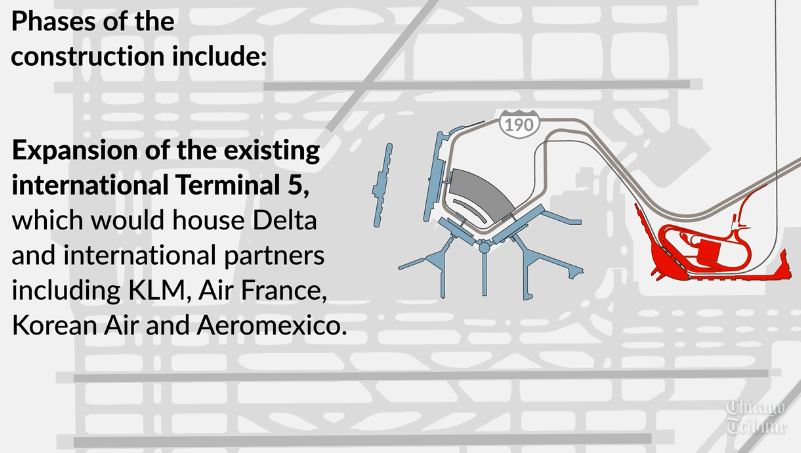
My first reaction to this is, “wow, that is a LOT of gates to hand over to SkyTeam.” Now, on one hand, that is a good thing: Chicago is an important market for AeroMexico, given the vast Visiting Friends and Relatives (VFR) market in the Chicagoland area and the business ties to the Mexican-American immigrant community. Chicago has also always been a big market for Korean Air for many years, as they sometimes bring in a large-gauge 747-8I or add additional weekly frequencies. But, additionally, Delta has been aggressively adding capacity to some of its spoke markets in recent years, like Boston, Raleigh/Durham, and Orlando, to name a few, and Chicago may be in the pipeline for Delta to add additional mass in the future. Chicago has connectivity to all of the Delta hubs, and shuttle service to New York LaGuardia. Put simply, it is definitely not an insignificant market for Delta.
Delta has also tried its hand at competing in the very saturated Chicago to London Heathrow market, first by announcing flights on its own metal, then canceling it, then relying on its joint venture partner Virgin Atlantic to operate it, then pulling out of Chicago – Heathrow altogether.
This one has me scratching my head a bit. I certainly love the idea of a Global Terminal connecting American and United to their alliance partners, no doubt, but I feel less excited about the satellite terminals. The amount of walking required to reach those facilities would be pretty exhaustive. Although, my gumption is that one of the satellite terminals could be used to house a mix of United flights and some international departures/arrivals, and the other would be used to house, “all other airlines” like Spirit, JetBlue, Alaska, Frontier, and Air Choice One.
Alternatively, these carriers will be housed in Terminal 5 along with Delta and Skyteam, although this hasn’t really been specified yet. It would be probably better for all of those carriers to co-inhabit Terminal 5 where they have 30 gates to split among them. Since International 5 will retain its FIS facilities, airlines like Spirit and Frontier, who operate international flights from ORD to Mexico and the Caribbean, can use these facilities.
Back at the American concourse, it will have Terminal 3 all to itself.
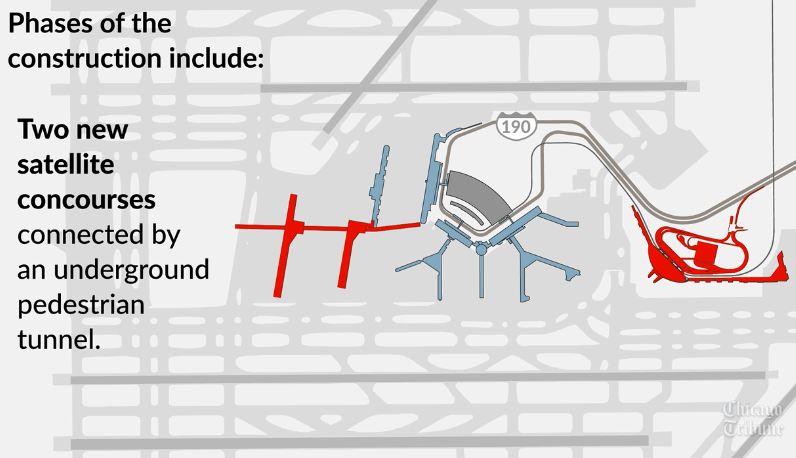
Then again, from a congestion perspective, the east-west runway usage, with six parallel runways in use, wouldn’t be all that suboptimal in terms of aircraft taxing to and from the satellite terminals.
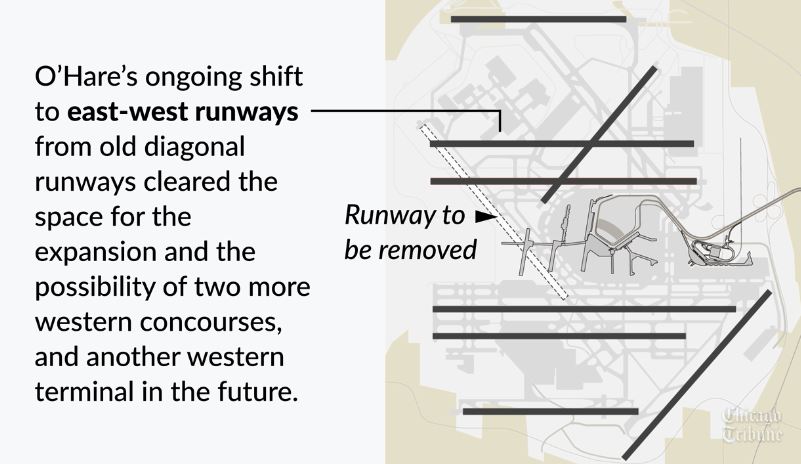
The improvement plan calls for non-airline/terminal enhancements as well, including a renovation of the Hilton hotel at O’Hare (please planners – if you’re reading this, add an observation deck, or at the very least, a rooftop pool/gym/aviation-themed bar that overlooks the airport!) and the construction of a new hotel at the existing Terminal Five and another one at a multimodal facility with rental cars, buses and parking.
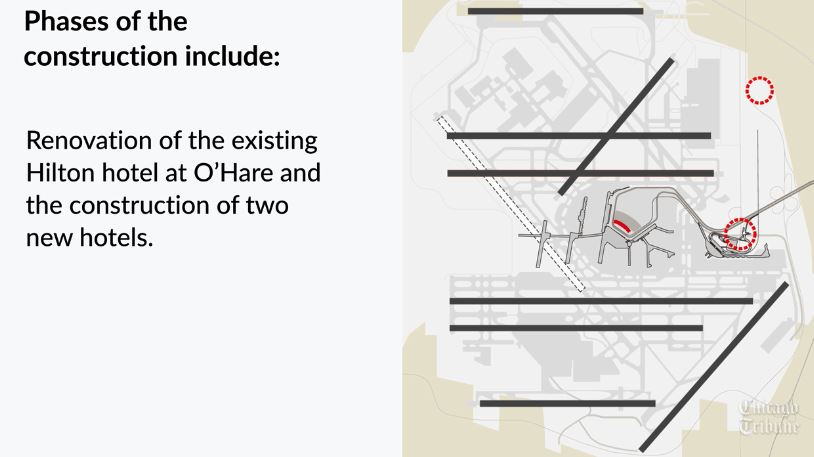
My Take on the Matter
In one word, I can sum up where the inspiration for this idea came from: Heathrow.
Since the opening of British Airways’ Terminal 5 at London Heathrow over a decade ago, the airport has gradually shifted from being a hodgepodge mess where different carriers were stuck in any corner they fit into, to being somewhat more of a civilized airport where alliance partners are co-located (somewhat). LAX and JFK, to a lesser extent, have taken similar measures. These days, airline alliances are no longer as dynamic as they used to be, given that most, if not all, of the major intercontinental carriers, have either joined one, opted out for the long-term, or formed strategic partnerships on a one-off basis with individual airlines (like WestJet with Delta or Aer Lingus with IAG).
Indeed, I will agree with Rahm in that this is a once-in-a-lifetime opportunity for O’Hare. Despite its associations with grandeur, the reality is that O’Hare hasn’t really grown as exponentially as other U.S. airports over the past 30 or so years. The level of investment in facilities and terminal space has indeed lagged compared to other airports. And there seems to be decent buy-in from not just American and United, but also from Delta, who is pretty kosher with the idea of moving to Terminal 5. Ultimately, however, having a Chicago Transit Authority connection to Terminal 5 would be optimal in the event that the plan is approved.
The plan isn’t flawless, but it is better than any other one that I’ve seen in the past 70 years. I am keeping my fingers crossed for it to clear.


